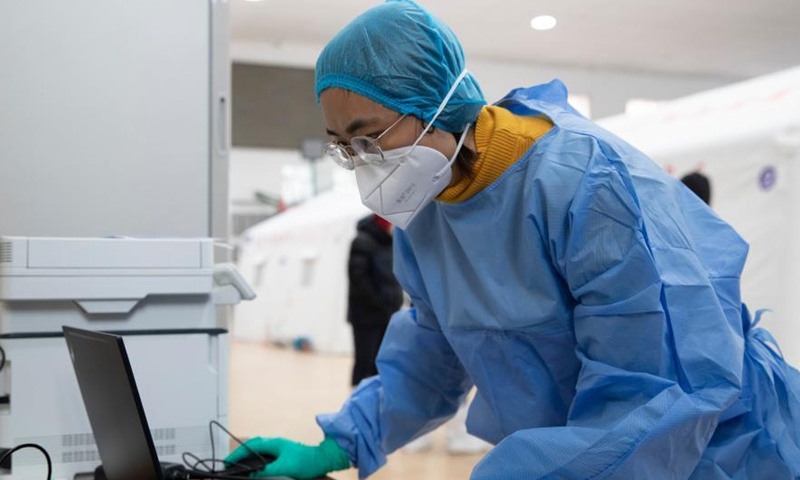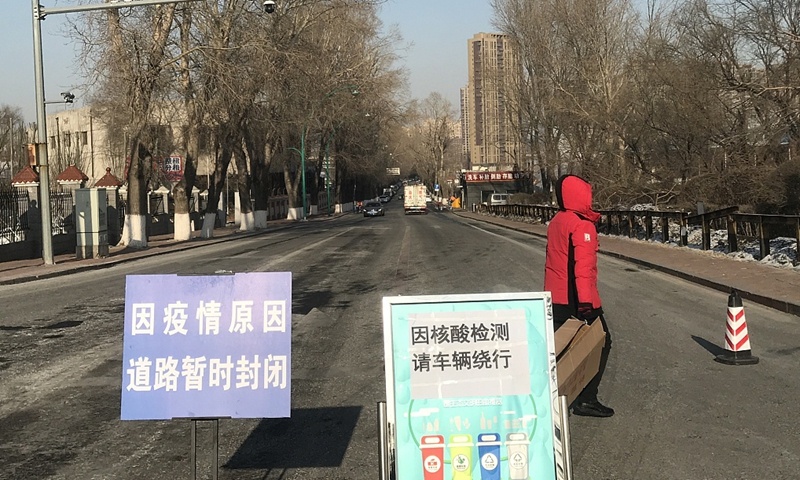
A staff member works in a temporary COVID-19 testing lab in Wangkui County, northeast China's Heilongjiang Province, Jan. 17, 2021. Northeast China's Heilongjiang Province reported 12 new confirmed COVID-19 cases and 19 asymptomatic infections on Saturday, local health authorities said Sunday. (Photo: Xinhua)
Northeast China, especially Jilin Province, is suffering from a resurgence in COVID-19 cases, mostly with asymptomatic patients, so areas in the region are carrying out large-scale nucleic acid testing for all local residents to discover silent carriers.
Chinese medical experts said this is necessary and have reassured the public that the country’s COVID-19 testing capacity is sufficient to test all citizens within one month.
The province reported another 46 cases on Tuesday, of whom 34 were confirmed after being diagnosed as asymptomatic patients.
Since the outbreak following imported cases on January 10, 190 cases have been found in Jilin Province as of 9am on Tuesday, including 133 confirmed cases and 57 asymptomatic infections, Jilin’s government said at Wednesday’s press conference.
The government said the recent confirmed cases were mainly those who had been silent carriers, and 111 asymptomatic cases have been confirmed, accounting for 83.45 percent of the cases so far.
Also, this outbreak is mainly clustered infections, said the government.
Notably, there was a super spreader reported in Jilin who arrived in the province and moved around in two areas from January 6-11, with 144 people being in close contact.
The person was in contact with a large number of people in a confined space for a long time, resulting in cluster transmission.
Of those infections found so far in Jilin, 92 were close contacts of the super spreader and 52 were related personnel with the close contacts.

(File Photo: VCG)
At the press conference, Jilin authorities said the new cases are mainly elderly residents, with 60.53 percent being over 60 years old.
In response to the epidemic, the province has launched large-scale testing and several key areas have carried out full testing for all their local residents.
Changchun, Tonghua and Songyuan have completed 2.448 million nucleic acid tests to detect cases in a timely manner.
Tonghua launched the second round of citywide testing on Tuesday evening. The city has been hit hardest amid this outbreak and it recorded 36 cases on Tuesday, lifting the total number to 94 confirmed cases this time.
All residential communities in Tonghua are now under closed management, and public transport has been suspended, said the mayor of Tonghua.
Songyuan vowed to start large-scale testing for its residents in the main urban area from Wednesday to Friday.
Another city in Jilin, Meihekou, said it will carry out two-day citywide testing on Thursday.
Yang Zhanqiu, deputy director of the pathogen biology department at Wuhan University, told the Global Times on Wednesday that the increased rate of silent carriers in the recent cluster infections could potentially result in the virus spreading faster and being more difficult to control, so the current urgent task is to discover silent carriers through wide-range nucleic acid testing in risky areas.
The citywide and district-wide tests launched by areas in Jilin are necessary before the Spring Festival holiday which usually sees a large flow of people in China, Yang said.
But Yang offered reassurance by saying that although the silent carriers are hard to find, they have lower levels of the virus than confirmed cases and are thus less likely to cause a major outbreak.
Aside from the testing, people should maintain social distancing and avoid gathering together, he suggested.
Although some people are concerned about the country’s testing capacity, Yang said it is “very sufficient” and the testing is “very fast,” with results coming within a few hours.
“For example, there are some seven nucleic acid testing instruments in our lab and they can complete thousands of tests in one day,” he said.
“China is able to test all its citizens within one month,” Yang said.
Heilongjiang, another province in Northeast China, is seeing a downward trend in COVID-19 cases following its recent outbreak but local officials said this doesn’t mean that the peak of this wave of the epidemic has passed.
The province reported 16 new confirmed cases and 31 asymptomatic patients on Tuesday, lifting the total number of confirmed cases to 172 during the past nine days.
Wangkui county in Suihua, which has suffered most from the epidemic in Heilongjiang, was ranked as a high-risk area on Tuesday.
Areas in the province including Qiqihar City and Suihua have also launched large-scale testing for all local residents.


